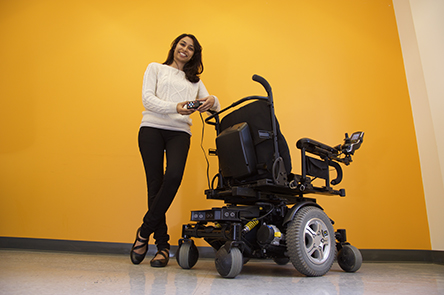Research
Contact
Communications Specialist
Faculty of Engineering
Spencer Engineering Building
Room 2072
Western University
Tel: 519-661-2111 ext. 87015
Email: engineeringcomms@uwo.ca
The Engineer's Impact - Pooja Viswanathan
Your inside look at faculty’s research and its effect on society
In this new Q&A series, we’ll feature Western Engineering faculty members to gain a succinct overview of their research, understand its impact on society, and discover intriguing little-known facts.
Meet Electrical and Computer Engineering Assistant Professor Pooja Viswanathan.
Can you describe your research?
 My research focuses on improving the safety and independence of individuals with physical disabilities. I have expertise in computer vision, robotics, artificial intelligence, user-centered design, mixed methods research, knowledge translation, and commercialization. Previously, my work resulted in the development of the first commercial blind spot system for wheelchairs. Currently, I am working on creating solutions to make the built environment more accessible, thus promoting increased activity and participation for people with disabilities.
My research focuses on improving the safety and independence of individuals with physical disabilities. I have expertise in computer vision, robotics, artificial intelligence, user-centered design, mixed methods research, knowledge translation, and commercialization. Previously, my work resulted in the development of the first commercial blind spot system for wheelchairs. Currently, I am working on creating solutions to make the built environment more accessible, thus promoting increased activity and participation for people with disabilities.
How does your research impact society in everyday life?
Using sensor technology, my research identifies mobility challenges faced by individuals with disabilities and devises solutions to enhance their quality of life. It aligns with the Accessible Canada Act, which is pivotal federal legislation aiming to achieve a barrier-free Canada by 2040.
What’s an interesting, little-known fact related to your research?
Over 8 million Canadians have disabilities, and a project led by the University of Calgary, "Mapping our Cities for All," revealed that nearly 60 per cent of public spaces in Calgary, Vancouver, and Ottawa are either inaccessible or partially inaccessible to people with disabilities. Studies have shown that a significant portion of wheelchair users experience accidents, resulting in property damage, mobility device damage, and hospitalization. These statistics underscore the urgent need for developing solutions to enhance accessibility and reduce barriers for all.

